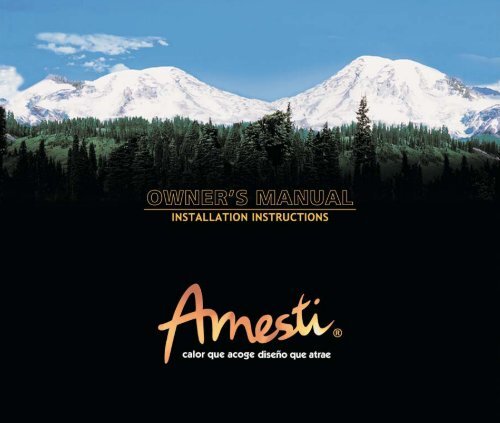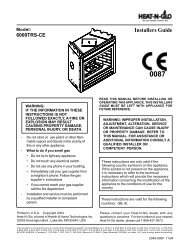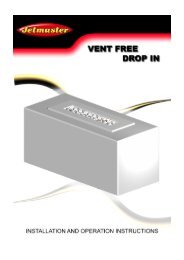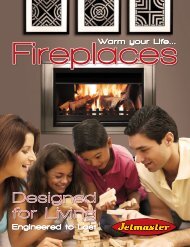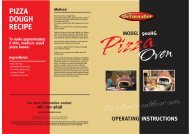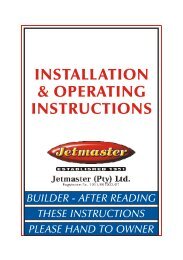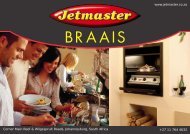You also want an ePaper? Increase the reach of your titles
YUMPU automatically turns print PDFs into web optimized ePapers that Google loves.
INSTALLATION INSTRUCTIONSCowl(stainless steel)Funnel(stainless steel)THE FLUES ARE THE MOST IMPORTANT COMPONENTS REGARDING THE FIREPLACESAFETY. THEY MUST BE INSTALLED ACCORDING TO THE INSTRUCTIONS AND KEPTAWAY FROM ANY FLAMMABLE MATERIALS.ADDITIONALLY, LEGAL NORMS AND LOCAL REGULATIONS MUT BE RESPECTED.Be environmentally friendly - avoid moist woodOuter Flue (zinc-alum)It covers the main flue from theceiling to the cowl. Mineral wool isinserted between the main flue andthe outer flue for insulation.Flashing(zinc-alum)Mineral WoolIs located between the maincanyonand the double canyonDistance to CombustibleMaterialAny flammable material must be aminimum distance of 15 cm. fromthe outer flueCeiling plate(stainless steel)Main Flue (stainless steel)It extends from the top of thefireplace to the cowl.Protection (refer to table)If your wall is wooden and you wantto put the fireplace close to the wall,place a metal or other nonflammable material plate on thewall, leaving space behind it for aircirculation.Metal BaseThis must be used if the floor iswooden, or is covered with carpetor plastic.1 Choose the location for the fireplace. Werecommend it to be positioned in the center ofthe room to be heated. If the wall is made offlammable material, you must apply the minimumdistances shown in the graphic and table. If youwant to position the fireplace close to the wall, youneed to protect it with a metal or non-flammableplate, 10 cm wider and 30 cm higher than thefireplace itself and separated from the wall by 3cm in order to allow free air circulation. If the flooris wooden, plastic, or covered with carpet or anyother flammable material, you must use a protectivemetal or non-flammable material base underthe fireplace.Fill the space between the main and outerflue pipes with the mineral wool supplied.The flue pipe should be as straight and verticalas possible. If required, you can use up to two 45ºbends. The vertical path should be twice as long asthe horizontal. All bends should be after the first lengthof flue and before the outer flue commences. Toensure optimal performance, the length of the mainflue should be more than 4 meters long and less than11 meters. Do not place any turnbuckles or regulatorson the main flue, since they can alter the fireplace’sperformance.cmcon protecciónsin protecciónA X Y14287 520 15Locate the center of the main flue in theceiling and drill a hole through the ceiling androof. If the roof is made of wood, the bore shouldhave a 55 cm diameter. In the attic section, placethe outer flue concentric to the main flue. Noflammable material should be within a 15 cmrange of the outer flue. The outer flue shouldrest on the ceiling plate.
The main flue, cowl and funnel are made ofhigh grade stainless steel. The outer flue and theflashing are made of zinc-aluminum. The main andouter flue sections must be fastened together withstainless steel screws or rivets (inside the house,place the rivet at the back of the main flue; in theceiling and above the roof, use three rivets/screwsat each join on both the main and outer flue).IMPORTANT: The main flue pipe unions must bedone in such a way that the upper section(s) fitsinside the lower one(s). The outer flue section(s)should be done inversely, with the lower sectioninside the upper.MAIN FLUEOUTER FLUE7 You must thoroughly waterproof theflashing where it meets the roof sheetingand where the outer flue goes throughthe flashing. Consult your hardware orspecialist waterproofing company for themost suitable products and techniques.NB: Depending on your ceilingheight, your main fluemight be too long or tooshort. If the main flue is toolong, cut the flue pipe to size asdepicted in the diagram. If the mainflue is too short, purchase an extralength and cut it to size.8 The outer flue must be fixed to theceiling structure by metal profiles (notprovided). There must be a minimumdistance of 15 cm from any flammableelement. If the outer flue extendsmore than one meter over theroof, or if the area is windy,use tension wires to fastenthe outer flue to the roof.The cowl, funnel and the upperedge of the main flue must bescrewed or riveted to one another(provided on inside cover of box).The funnel must be free from theouter flue to allow for thermal expansion.NB. This union must not bescrewed.NB: Depending on your ceilingheight, your main flue might be toolong or too short. If the main flue istoo long, cut the flue pipe to sizeas depicted in the diagram. If themain flue is too short, purchase anextra length and cut it to size.USEFUL HINTSExpansionAreaCowlScrewed union(main flue, funneland cowl)FunnelExpansion FreeUnion (betweenfunnel and outerflue)Mineral WoolOuter FlueMain FlueDOWN DRAFTIf wind collides with an obstacle, there will be turbulence that can cause smoketo blow back down the flue (down draft). To correct this situation, increase thelength of the flue so that it projects over the turbulence area.STAIRCASEIf the fireplace is near a staircase, the heat will flow towards the upper levels andwill not sufficiently heat the lower level. This can be corrected by putting a lintelaround the staircase, thereby distributing hot air around the lower level ceiling.LintelThe heat will flow towards the upper levelsThe hot air is distributing around the lower level ceiling.
OPERATION INSTRUCTIONSPRECAUTIONS- Make sure that your fireplace is installedaccording to the instructions.- Keep flammable objects away from thefireplace. This includes furniture, firewood,matches, plastic, clothes, etc.- Be careful when loading firewood insidethe fireplace. Do not load firewood whenthe fire is burning vigorously.- Use only dry firewood. Avoid using wet orgreen firewood, as well as pine species.Do not use mineral coal.- Never use gasoline, paraffin, wax, or any other flammable liquid to light orstrengthen the fire.- Do not burn paper or other material that could cause an extremely hot, rapid fire.- Do not operate your fireplace with the door open, except when lighting it.- Make sure the door gasket is in place and that the door closes completely.FIREWOODKEROSEN1 What kind and amount of firewood should be used?- Use firewood from eucalyptus, fruit, and other alien invasive trees. Avoid burningindigenous trees, since harvesting can produce irreparable ecological damage.Avoid pine due to its high sap content; sap can accumulate in the main flue andcause a fire hazard.- It is always advisable to use dry firewood. As a general rule, the harder thewood, the better fuel it will make.- Heat production is controlled not only by the control lever, but also by the type,humidity and amount of firewood placed in the fireplace.- A full fireplace operating on "HIGH" will generate more heat than one nearlyempty on the same graduation.Remember, the heat that is generated is equivalent to the calories from thefirewood. The more firewood, the better the heat2 How do I obtain dry firewood?- It is best to purchase firewood during summer and store it in a dry and protectedplace until you use it. This will enable the wood to dry.- Purchase firewood on a volume unit basis (cubic meter, square meter, loador truck load), not on a kilogram basis. The reason for this is that wood is heavierwhen wet, so a seller might prefer to sell you heavy (wet) wood, which increasesthe selling price.- A ton of eucalyptus firewood occupies approximately 1 meter base by 2meters high.STARTING THE FIRE1 Before using the fireplace for the first time:- Fit the damper as shown in the section“Fitting the damper” under Maintenanceand Cleaning.- Confirm that the flue is installed accordingto the instructions.- When the fireplace is lit for the first time,the fireplace will produce smoke and smelllike resin for a few hours. Open the windowsto ventilate.2 Lighting the fire- It is as easy as starting a camp fire.- Put wrinkled paper in the center of the fire box.- Place several wooden chips or sticks on the paper, preferably in a verticalposition and put some wrinkled paper ontop of sticks.- Slide the air control lever to "HIGH".- Light the paper. Once the sticks are burning, carefully open the door and addlargerlogs (place small logs on the bottom, and larger ones on top).- Once these logs start to burn, close the door and put the air command controlon"HIGH" for about 20 minutes. If the wood is not completely dry, leave the leveron “HIGH” for about 30 minutes.- When you ignite the fire using this technique, you will create a good base foreffective combustion without smoke or pollution.- When the fireplace reaches operating temperature and there is good draft, placethe air command in the desired position. We suggest adjusting the air commandslowly before reaching the "LOW" position. Extended combustion occurs whenthe air command is in “LOW” position.- It will take some time to familiarize yourself with your fireplace. Never expectan immediate response when sliding the air command lever. Unlike gas fires,solid fuels such as wood, have a slow reaction.Be environmentally friendly - avoid moist wood
STARTING THE FIRESCANTOOL AND FIRE TOOLS3 How to reload your fireplace while the fire is burning- Never open the door while the fire is burning vigorously. Wait until the firecalms down.- Slide the ashtray out so it can catch any live coals from the fire box.- Open the door. Insert fresh firewood into the fire box. Using a fire hook ormetal spade, move any live coals from the bottom of the firebox, and placethem over the new logs.- Slide the air control lever to “HIGH” for a few minutes. Once the flamesare vigorous, move the air control lever towards “LOW” to reduce air intakeand achieve the desired heat.4 Extended combustionIn order to achieve good combustion throughout the night, do as follows:1 Cold handle.The fireplace includes a metalhandle to open and close thedoor.This should also beused to move the aircontrol lever..This handle must behung in a separate place(not on the fireplace).Never leave the handlein the fireplace door.- Create a good base of live coal at the bottom of the fire box.- Load the fireplace with fresh firewood.Once the logs start producing flames, set to “LOW”.5 How to load your fireplace after an extended combustion?- After an extended combustion cycle, reset the fire by stirring the live coalunder the ashes with a fire hook or metal space, and add some sticks andsmall logs. Slide the air control lever to “HIGH” and allow the fireplacetemperature to recover before adding larger logs.- Reload your fireplace, as described above.2 ShovelThis is not included in the fireplaceset. Nevertheless, we recommendthat you purchase it, since it makescleaning easier. The shovel isspecially designed with straightangles to efficiently reach thefireplace’s corners.3 Fire hookThis is not included in the fireplaceset. It is very useful for movinglogs and lifting coals from underthe ashes.ASK YOUR DISTRIBUTOR ABOUT THESE TOOLS
MAINTENANCE AND CLEANINGMAINTENANCERemoving ash- Remove the ashes from your fireplace once the level reaches about 2 cmbelow the lower side of the door’s frame.- Push the pieces of log and coal towards the back part of the fire box.- Using a small shovel, remove the ashes and put them into the ash tray. Placingsand in the bottom of the pan will reduce the risk of fire. Take the ashes outof the house and put them in a safe place. Remember that live coal burns forup to 36 hours.Untreated wood ash is an excellent fertilizer for your garden.- Leave at least a 2.5 cm layer of ash as protection for the fire box bottom.GlassWhen the fireplace is cold, clean any stain that may appear on the glasswith a damp cloth. Avoid using any abrasive material that could scratch it.FITTING THE DAMPERAMESTI appliances are allotted with a unique cartridge type air-cooling damperthat must be installed prior to using the fireplace. It can be removed to cleanthe flue and can be replaced when it wears out. The life span of the damperwill rely on the conditions of operation, type and dryness of wood, it must beinspected annually. The damper must be fitted as follows:Cause of Smoking FireplaceBe environmentally friendly - avoid moist woodCREOSOTE FORMATION ANDTHE NEED TO CLEAN THE FLUE- Firewood combustion produces acetic and pyro-wood acid, which whencombined with humidity, produces creosote. This can settle on the lowerwalls of the main flue pipes, causing the following problem:- Combustion chamber and the chimney pipe become blocked, causing thefireplace to malfunction. Under these circumstances, the ignition will be slow,making it difficult to achieve effective combustion.- Clean according to instructions in section “Cleaning Your Wood-burningFireplace”.SMOKE COMING OUT OF THE FIREPLACEThere is no draft because the fire hasnot been correctly ignited.Wet firewoodBlocked flueSolutionLight the fireplace according to the instructions,using paper and wood chips. Leavethe door slightly open until the fires heatsup. Slowly add logs. Keep the fire burning.Replace the firewood with dry wood.Clean the flue (refer to “Cleaning”instructions.-Extend the flue as explained in theinstallation instructions.Down draft-Open a window near the fireplace whenstarting the fire.When opening the door to reload the fireplace, smoke normally comes out from theinner firebox. This can be reduced by reloading it in a short time, opening the frontdoor only when needed and using dry woodOpen the door and position thedamper in the firebox with thesmall holes facing down and thelarger hole for the oxygen tubefacing to the back of the firebox.Lift the damper to the top of thefirebox and slide onto the supports(towards you).DamperSupportSlide away from you untilit fits over the oxygentube.Push the damper untilit reaches the back wallof the firebox.Oxygen tube
CLEANING YOUR WOOD-BURNING FIREPLACE- An advantage of <strong>Amesti</strong> wood-burning fireplaces is that they can be cleanedwithout the need to disassemble them.- Creosote deposits form mostly in the main flue and in the second combustionchamber area.- You can get a professional chimney sweeper to clean the fireplace and flueor do it yourself. If the later, tools required for the cleaning process includea screwdriver, ladder, steel brush, ball, rope and a vacuum.Unscrew the cowl and take it off.WARNING REGARDING A CHIMNEY FIRECombustion gases can deposit debris such as soot, ash and creosote on themain flue inner walls, which, under certain circumstances, can cause a firein the lower part of the fireplace. This fire might move progressively up theflue resulting in a fire risk. The flue temperature will reach extremely highlevels (up to 1000ºC) while the deposits on the inner flue walls is burning Thisis the greatest risk with fireplaces and is why the flue must be made of amaterial that resists these temperatures, and that it be installed correctly.If an <strong>Amesti</strong> flue kit has been used and the installation instructions have beenfollowed correctly, the fire risk is significantly reduced, if not eliminated.What to do in case of chimney fire- Keep calm. A chimney fire will last until the deposited material on the fluewalls burns out. This takes between 5 and 20 minutes.- Close the fireplace door. Do not open it under any circumstances, not evento turn the fire off, or to take out the logs.Slide the ball from the upper part of thechimney until it is inside the firebox. Removethe damper in an inverse process from whatwas explained in the previous chapter.- Move the air control lever to the ”LOW” position.- Closely watch the material closest to the flue. If it starts smoking, cool itfrequently with a wet cloth.- If you can reach the attic, remove any flammable materials that might be incontact with or too close to the outer flue.- Watch the flue outlet on the roof. If sparks come out of the flue, immediatelywet the roof around the flue.How to avoid chimney firesPull the rope from within the fireplace, draggingthe steel brush through the inside of themain flue pipes. Then pull the steel brushback upwards and repeat 6 times. Do notuse a metal sponge instead of a steel brush.- Use only dry wood.- Never leave the fireplace door open for extended periods when a fire isburning.- Avoid low smoky fires – ensure vigorous combustion prior to setting the fireto extended combustion.- Clean the flue at least once a year.


